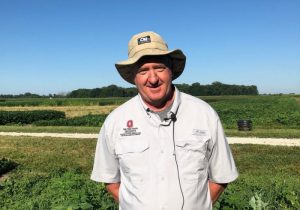Life in a time of glyphosate scarcity
By Dr. Mark Loux, OSU Extension Weed Specialist, Adapted from C.O.R.N. 2021-31 & 32
It’s been a strange couple of years. Shortages and supply chain problems. And just when you think anything else couldn’t happen, the supply of glyphosate, which is usually way more abundant than water in the American West, has apparently become short. This is forcing decisions about where glyphosate has the most value. We have talked with suppliers who are already saving the glyphosate for spring/summer next year and going with other options for fall burndown for wheat and later fall applications for winter weeds. In the end, we have alternatives, but at increased cost or reduced effectiveness in certain situations. A continued shortage will cause more problems in next year’s crops than it does now though.

Herbicide options for burndown of existing weeds prior to emergence of no-till wheat include glyphosate, Gramoxone, Sharpen, and dicamba. Among these, the combination of Sharpen plus either glyphosate or Gramoxone probably provides the best combination of efficacy on marestail, flexibility in application timing and residual control. While Gramoxone alone should control small seedlings of marestail and other winter annuals, its overall effectiveness is usually boosted by mixing with another herbicide, which could include Sharpen, or dicamba if applied if applied early enough ahead of planting. Dicamba labels have the following restriction on preplant applications – “allow 10 days between application and planting for each 0.25 lb ai/A used”. A rate of 0.5 lb ai/A would therefore need to be applied at least 20 days before planting. We do not know of any 2,4-D product labels that support the use of 2,4-D prior to or at the time wheat planting. There is some risk of stand reduction and injury to wheat from applications of 2,4-D too close to the time of planting. Liberty and other glufosinate products are also not labeled for use as a burndown treatment for wheat. This is not an injury risk issue – the company controlling the glufosinate label just won’t spend the money to label it for burndown in additional crops. Be sure to use the appropriate adjuvants with any of these, and increase spray volume to 15 to 20 gpa to ensure adequate coverage with Sharpen or Gramoxone.
Another option in fields that are not that weedy now is to skip the at-plant burndown and instead apply postemergence herbicides in early November. There are several effective postemergence herbicide treatments for wheat that can be applied at that time to control most winter annual weeds. Effective postemergence treatments for the weeds commonly encountered include Huskie, Quelex, or mixtures of low rates of dicamba with either Peak, tribenuron (Express etc), or a tribenuron/thifensulfuron premix (Harmony Xtra etc). We discourage application of 2,4-D to emerged wheat in the fall due to the risk of injury and yield reduction. It’s also possible to use a combination of tribenuron or tribenuron/thifenslfuron with a low rate of metribuzin (e.g. up to 2 oz/A of 75% formulations). The dicamba mixtures have been effective on dandelion in OSU research. Where winter annual grasses are present, be sure to use the appropriate postemergence herbicide based on the grass species. The wheat herbicide effectiveness table in the weed control guide has ratings on several key grasses. Fall-applied herbicides are more effective on these grasses than spring-applied. Note – the Anthem Flex ratings are for residual control only, not control of emerged plants.
We suggest keeping the cost of fall applications low, avoiding use of most residual herbicides, starting with at least 0.5 lb ae of 2,4-D, and then adding one of the following herbicides:
– Glyphosate – rates as low as 0.38 lb ae/A can be enough in many fields. Increase rate for perennials and weedy fields.
– Dicamba – base rate of 0.25 lb ai/A. Available as premixes with 2,4-D. Our experience is that cold weather affects dicamba more than some other herbicides. This mixture can be less effective on deadnettle and a few other weeds than the other mixtures here, so fields may not look quite as clean in April.
– Metribuzin or Simazine – weaker on dandelion and other perennials than the others listed here but basically get the job done. Metribuzin can be used before corn or soybeans, simazine only before corn
– any of a number of short-residual ALS-inhibiting herbicides/premixes containing tribenuron and/or rimsulfuron (Basis, Express, Audit, Panoflex, Nimble etc). Most of these can be used before corn or soybeans.
– Canopy/Cloak and other chlorimuron-containing products. These can be used prior to soybeans only and are really the only herbicides on this list that provide a combination of burndown and decent residual activity into spring. Rates at the low end of the rate range are adequate for this.
What is evident from this list it that glyphosate does not have to be an essential component of fall herbicide treatments, and there are other low-cost options. Grasses, and especially perennial grasses, may require the use of glyphosate. We have been hearing a lot about annual bluegrass, because it has been tough to control in the spring. Fall-applied herbicides are effective on this weed, and glyphosate is not the only option (herbicide ratings here). Alternatives to glyphosate for annual bluegrass include Canopy/Cloak, Autumn Super, and Basis and its generic equivalents. Clethodim can be used for control of grasses in fall, but cold weather and mixing with 2,4-D reduce its effectiveness. Although we have not really used it in the fall much, Gramoxone plus 2,4-D is another option for control of most annuals. Activity would be affected by cold and cloudy weather, and we consider this treatment generally more variable and expensive than those listed above. Gramoxone has activity on bluegrass, although is potential for regrowth if warm weather persists into late fall. Note – this information refers to annual bluegrass, not rough bluegrass, which is a completely different animal and requires decent rates of glyphosate.